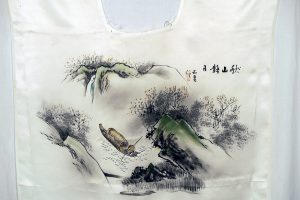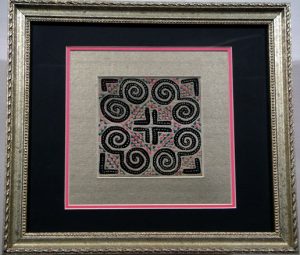Description
The most intriguing aspect of this Informal Man’s Haori is the fact that the main source of decoration is on the inside of the garment, or the lining. Thus, it follows the tradition of the most spectacular of the textile artworks created from the 16th through the 19th centuries…those intended for personal satisfaction. The inner back panel of this Haori has been hand painted and signed by the artist using the labor intensive “Rice Paste Resist” method to portray the Seven gods. This technique requires that each color be applied separately, while all the others were painted out in the rice paste. Each time a new color was added; the rice paste had to be removed by soaking it out over and over again in the local river water and then reapplying it for each remaining color. This was an intense, tedious, and laborious process that required tremendous skill on the part of a Master Artist.
The Japanese grouping of the Seven gods of Good Luck dates from the Edo Era, although the gods reflect concepts, symbolic associations, and characters derived from ancient legends. By grouping them together, the Japanese mix symbolic motifs from the religions of Taoism, Buddhism, and Shinto in such a way that no one religion may be identified over another. This assemblage reflects Japan’s eclectic approach to religion. The gods generally appear together, although each represents a specific theme. These are: (1) Jurojin, the patron of learning; (2) Fukurokuju, a god of wisdom and longevity; (3) Daikokuten (Daikoku), associated with prosperity; (4) Ebisu, the patron of fishermen; (5) Hotei, associated with the welfare of children; (6) Benzaiten (Benten), female deity associated with the accumulation of worldly goods and the patroness of music and art; (7) Bishamonten, who represents the northern quadrant of the universe and usually appears clad in armor carrying a small pagoda and trident.
This is a striking example of the Informal Man’s Topcoat or Haori. It appears black on the outer layer of the garment that holds a masterful plaid that also includes some dark blue. It also becomes a reversible topcoat, depending on the wearer’s decision. There are no crests on this Haori indicating that it was intended for use in the home or, at most, to visit a close friend or relative. The lightness of the exterior Silk also indicates that this garment would have been worn in comfortable settings, i.e. the home. The Informal Haori represents the height of “at home” wear for Japanese men and was, obviously, specially ordered for a rich and high ranking individual as the hand painted inner panel bears the signature of the artist.
** Shipping included within the continental United States.









